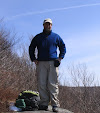On a cold, cloudy flurry-ish day I returned to one of my favorite bushwhack destinations - the 1995-vintage slide in the seldom-visited, nameless basin between Little Haystack Mountain and Mt. Liberty. This would be my fifth visit to this slide, and my third on snowshoes. In fact I was just out there in November, on bare ground, but the trip is a whole different experience in winter. In particular, the snow piles deeply at the base of the slide, with several opportunities to experience the delight of plunging hip-deep into a spruce trap.
How often do you see just one car at the Old Bridle Path/Falling Waters trailhead at 9:30 in the morning?

The first crossing of Dry Brook on the Falling Waters Trail was well-frozen. I launched the 1.5 mile bushwhack to the slide here.
At the start of the whack, I could tell that the deep soft snow would make this a long, slow trek.
Good thing I put the tails on the MSRs for this trip.
A fine old yellow birch.
The long and winding road.
Partway along, the route levels out on a nice hardwood plateau.
This glade with two old leaning sugar maples is a familiar landmark along the route.
Survivor of many hard winters.
Weaving through some crevassed little creeks, which can be challenging to cross in winter.
Plenty of unconsolidated snow out here!
Into the softwoods, ascending along the south edge of Little Haystack's SW ridge.
Most of the woods on this part of the route are wide open.
We'll take it!
There were a few thicker stretches to push through or circle around.
In deep.
Four hours into the hike, I drew across from the south fork of the two-pronged slide. With flurries sweeping across the valley, views from the slide seemed unlikely.
The most challenging part of this hike is a short but very steep drop through dense conifers into the drainage. As I had on my November trip, I got impatient and descended too soon, ending up on the brookbed/slide track a bit below the slide proper. Getting from here to the slide was difficult due to deep soft snow and hidden spruce traps.
Those are the handles of my poles.
A white pine - one of a half-dozen I've seen on this slide - is hanging in there amidst the spruces.
After extricating myself from a waist-deep spruce trap, I pushed through this thicket.
Navigating along the edge of the streambed/slide track.
This steep mound of snow loomed ahead.
It offered a partial view up the south prong of the slide.
That was a struggle!
At 2:15 I finally made it to the base of the main (north) prong of the slide. Elevation here is 3200+ ft.
As I ascended this lower angle section, I looked back and saw that the Kinsmans were emerging from the clouds.
Heading up a powdery snowfield.
A small, lone tamarack pokes out of the snow.
Deep snow on the right, wind-scoured and bony on the left.
I climbed to this point on the slide, and was tempted to go higher, but I'd been on the move for five hours and needed to take a break. Plus, the view of the Kinsmans is almost as good from the lower part as it is above.
Looking across to the ridge leading up to Little Haystack.
Down-look. The snow was stable, in line with the day's Mount Washington Avalanche Center forecast for low avalanche danger on the east side of Mt. Washington.
Side view across to a white pine that doesn't look healthy.
I found a spot with some surprise mid-afternoon sun and settled in for a late lunch while gazing out at the snow-caked Kinsmans.
Zoomed. I had expected no views on this day, so this was a treat.
A line of stately spruces.
View from the bottom.
After negotiating a crossing of the deeply crevassed drainage at the base of the slide, I scrambled up the bank on the far side and found a full length view.
Looking down at the steep climb out of the drainage.
Golden hour heading down the ridge.
Sunset in the hardwoods. I didn't use the headlamp until I reached Falling Waters Trail.











































No comments:
Post a Comment